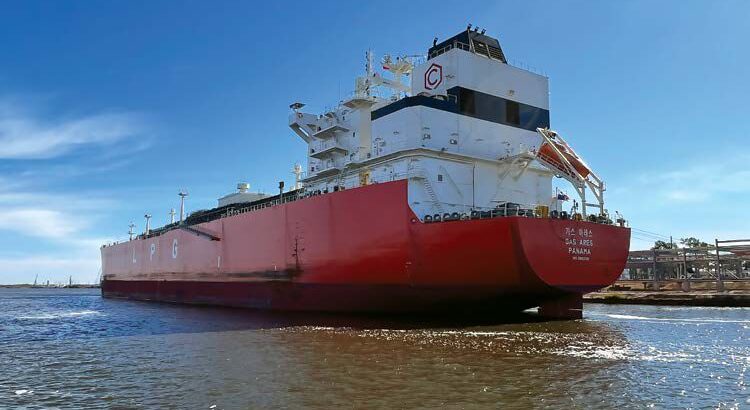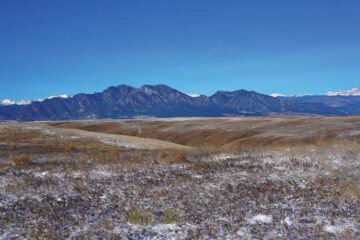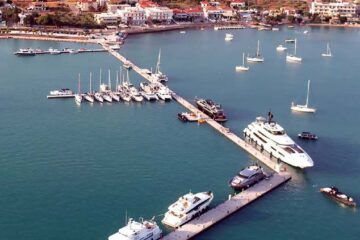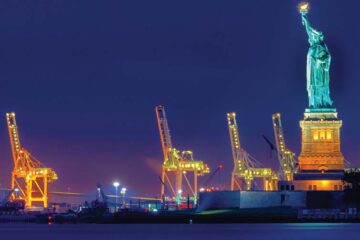On November 25, 2021, at 2227 local time, the liquefied petroleum gas carrier Gas Ares was transiting upbound on the Neches River in Port Neches, Texas, with 24 persons on board, when it collided with the outermost of two harbor tugs moored alongside the no. 1 loading dock at the Motiva Port Neches Terminal. No injuries or pollution were reported. Damage to the tugs and dock was estimated at $1,057,000.
(In this report, all times are central standard time, all miles are nautical miles [1.15 statute miles], and all speeds through the water are knots).
Background
The 754-foot-long, 106-foot-wide liquefied petroleum gas (LPG) carrier Gas Ares had a single right-hand-turning propeller directly driven by a slow-speed diesel main engine rated at 16,432 hp. It had a single rudder and was not outfitted with a bow thruster. Built in 2020, the ship was owned and operated by KSS Line, which was based in Seoul, South Korea.
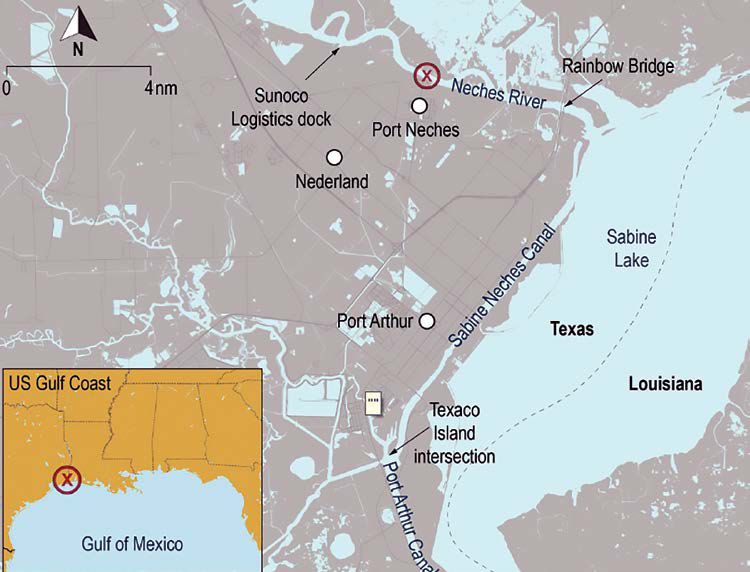
Casualty Events
On November 23, 2021, at 0800, the Gas Ares anchored at the Sabine Bank north anchorage in the Gulf of Mexico to await an available berth after arriving in ballast from Yeosu, South Korea. The Gas Ares was due to load a cargo of propane and butane at the no. 1 loading dock at Sunoco Logistics, located in Nederland, Texas, on the Neches River.
On November 25, about 1736, the Gas Ares got underway from the anchorage area headed toward the sea buoy for the entrance to Sabine Pass. The vessel’s draft was 6.4 meters (21 feet) forward and 8.2 meters (26.9 feet) aft. About 1748, a statelicensed pilot from the Sabine Pilots boarded the Gas Ares near the sea buoy. After arriving on the bridge, the pilot and master conducted a master/ pilot exchange; the master provided the vessel’s critical dimensions and handling characteristics, while the pilot provided the expected weather, current, traffic conditions, and the plan for the use of assistance tugs. The master reported there were no defects or deficiencies related to navigation, communication, steering, or propulsion systems.
To reach the loading dock, the Gas Ares had to transit through the Jetty Channel, Pass Channel, Port Arthur Canal, Sabine Neches Canal, and Neches River. The pilot stated that because of the wind conditions, which were predicted to be 18-25 knots from the north, she planned to have one escort tug. The Hayley Moran (a 6,000-hp tractor tug) was to meet the vessel at the Texaco Island intersection and accompany it through the Sabine Neches Canal and Neches River. Additionally, she requested a second tractor tug be available to assist in turning the ship for the maneuver to the Sunoco Logistics dock.
After the master/pilot exchange, about 1754, the pilot took the conn (navigational control of the vessel) and began to maneuver the Gas Ares through the Jetty Channel. The master, officer of the watch, and helmsman were on the bridge, and a lookout/anchor watch was positioned on the bow. Throughout the transit, the pilot communicated to the bridge team relevant navigation information, plans, and passing arrangements, which the bridge team acknowledged. About 2024, while the Gas Ares was transiting the Texaco Island intersection, the escort tug Hayley Moran joined the LPG carrier. The tug was made fast with a line through the Gas Ares’s stern center roller fairlead before the LPG carrier continued upbound in the Sabine Neches Canal.
At 2152, the Gas Ares passed through the Rainbow Bridge and proceeded upbound on the Neches River. At 2208, the pilot on the Gas Ares hailed the downbound towing vessel Chad Douglas, which was pushing two loaded tank barges in a single line ahead (measuring 688 feet long by 54 feet wide) and arranged for a starboard-to-starboard passing. At the time, the LPG carrier was transiting at 8.1 knots at a half-ahead propulsion order (61 rpm). At 2211, still at half ahead at 9 knots, the pilot ordered the Gas Ares’s propulsion to slow ahead (48 rpm), and 1 minute later ordered dead slow ahead (31 rpm). The pilot told investigators that she ordered the vessel’s speed reduced to minimize the wake generated by the Gas Ares before passing a pipeline removal project ahead and to starboard near the river’s north shore outside of the navigation channel; she stated that she wanted to avoid upsetting the pipeline removal project vessels and equipment or injuring any personnel that may have been on those vessels (see figure 3 for location of pipeline removal project). At 2213, the pilot ordered slow ahead on the engine followed by dead slow ahead about 25 seconds later.
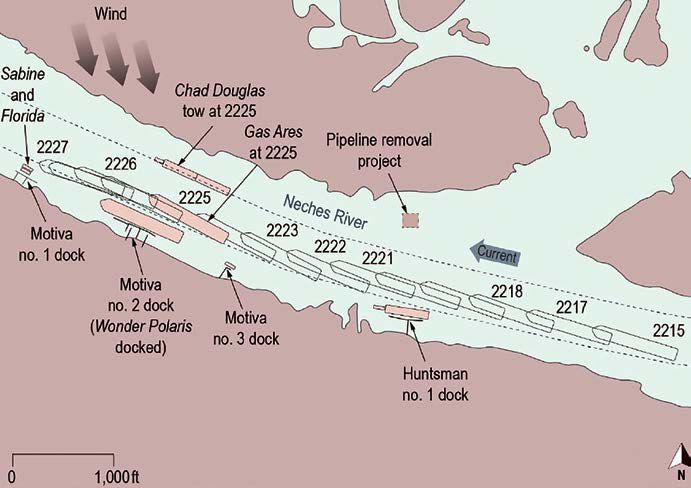
At 2215, the pilot contacted the operator of the Chad Douglas and requested he reduce his tow’s speed, which she later explained to investigators was to “avoid meeting three wide across from Motiva” (an 820-foot-long, 144-foot-wide tanker Wonder Polaris was docked at the Motiva no. 2 loading dock), and the Chad Douglas operator agreed to slow.
At 2217, the pilot requested the Hayley Moran pull the Gas Ares’s stern to starboard. At that time, an articulated tug and barge (ATB) was ahead and to port of the Gas Ares, moored alongside the no. 1 loading dock at Huntsman Corporation (on the south shoreline). The pilot said that as the Gas Ares slowed, the wind, “blowing from the north,” started affecting the vessel’s maneuverability, setting it toward the moored ATB.
At 2218, with the Gas Ares at a speed of 3.8 knots, the pilot ordered an rpm increase to slow ahead, and 2 minutes later, she requested half ahead, followed by slow ahead 10 seconds later. She also used the Hayley Moran to pull the vessel’s stern to starboard several times. About 2221, according to radar images from the Gas Ares’s voyage data recorder (VDR), the ship was clear of the pipeline removal project to starboard. The pilot asked if the port stern was clear of the ATB at the Huntsman dock, and the officer of the watch reported to the pilot that it was clear.
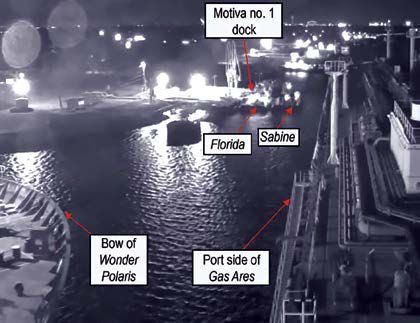
At 2222, the pilot of the Gas Ares called the operator of the Chad Douglas and asked him to “drive on it [come to full speed] so I can get past this ship [Wonder Polaris]” and told him that she was “having a hard time with this flood” (at the time, the surface current was about 0.4 knots measured at a sensor at the Rainbow Bridge). The pilot further communicated to the Chad Douglas’s operator that she was going to angle the bow of the Gas Ares at (toward) him. The operator of the Chad Douglas responded that he would drive “straight on.” With the wind about 25 knots from 343° (off the Gas Ares’s starboard side), the pilot issued multiple rudder orders, a half-ahead propulsion order, and an order to the tug to “get the stern out.” At 2224, the Gas Ares, which was still on the navigable channel’s southern limit at a speed of 4.1 knots, passed the Motiva Port Neches Terminal no. 3 loading dock (on the south shoreline up river from the Huntsman dock), where a towing vessel was moored. At the same time, the bow of the Gas Ares passed in line with the stern of the Wonder Polaris moored port side to the Motiva no. 2 dock (also on the south shoreline, up river from the Motiva no. 3 dock). About a minute later, the downbound Chad Douglas tow, which was near the northern limit of the navigation channel, passed the Gas Ares starboard to starboard.
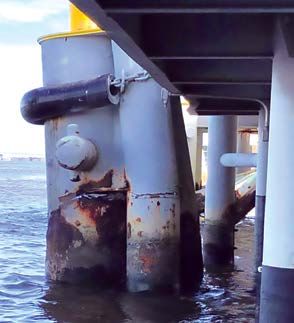
At 2225, with the Gas Ares passing the moored Wonder Polaris closely to port, the pilot ordered “five short blasts” of the ship’s whistle, which she later told investigators was to “alert everyone.” She then requested of the Hayley Moran, “give me what you got; starboard 45°.” Simultaneously, she issued multiple rudder orders—hard to starboard, midship, and hard to port—and ordered the engine full ahead (71 rpm), then half ahead 30 seconds later, followed by stop engine 18 seconds afterward. At 2226, with the port stern of the Gas Ares still closing on the Wonder Polaris, the pilot requested dead slow ahead, followed seconds later by slow ahead and stop engine.
The Motiva no. 1 loading dock, which had two harbor tugs moored side by side alongside the dock, was ahead of the Gas Ares on the south shoreline on the LPG carrier’s port bow. The tug Sabine was outboard on the channel side with the tug Florida moored inboard and alongside the dock, both facing up river.
The Gas Ares continued ahead at 4.1 knots, and the pilot saw that the vessel’s bow was moving toward the tugs moored at the Motiva no. 1 dock. Consequently, she issued the following orders in quick succession: 1) the Hayley Moran pull full to starboard; 2) rudder amidships; 3) again sound “five short blasts” of the ship’s whistle; 4) let go the starboard anchor; and 5) engine emergency full astern. The bridge team complied with her orders.
On board the Sabine was a crew of four; the captain had been in his stateroom when he heard a ship’s whistle. He went to the wheelhouse, where he saw the Gas Ares approaching. He rang the general alarm, and the engineer started the main propulsion engines. Recognizing the Gas Ares was going to hit them before they were able to get underway, the tug captain announced to the crew over the public address system to “hang on.”
On the Gas Ares’s bow, a crewmember released the starboard anchor at 2227, and at the same time, as the bow continued to fall to port, the Gas Ares’s port bow collided with the Sabine on its starboard side. The Sabine’s mooring broke, and the tug was pushed into the adjacent tug Florida and moved up river. The Florida, which had four crewmembers on board, was driven against the dock but remained moored. According to the Gas Ares’s VDR information, the wind at that time was about 15 knots from 348° (off the starboard side).
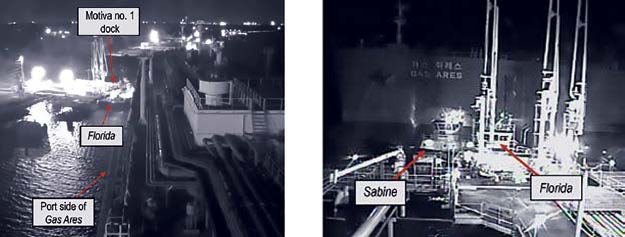
After colliding with the Sabine, the bow of the Gas Ares moved away from the tugs, and the ship began to make sternway at 2228 with about 1.5 shots (135 feet) of anchor chain in the water. The Hayley Moran remained on the stern of the Gas Ares, holding the stern from being set by the wind into the Wonder Polaris. When the Sabine’s engines were ready for use, the vessel left the immediate area to make room for the Gas Ares, and shortly after, the Florida also got underway. There were no initial reports of injuries to the crew of either the Sabine or Florida. The Motiva no. 1 dock had no employees on it at the time.
The pilot of the Gas Ares requested Vessel Traffic Service Port Arthur have additional tugs in the area to come to the LPG carrier’s assistance. The tug Florida made fast on the starboard bow of the Gas Ares. Once additional tugs were made fast to the Gas Ares and there were no findings of damage on board, the pilot ordered the anchor heaved, and once it was aweigh at 2240, she conned the vessel onward to the Sunoco Logistics no. 1 dock about 3 miles up river without further incident.
Additional Information
Damage
The Gas Ares’s port bow sustained minor damage consisting of an indentation and scratch in the shell plating above the waterline. No post-casualty survey was conducted.
The tug Sabine sustained damage to its starboard main engine/generator stack plating, anchor handling boom, onboard image recording system, and about 11 feet of its starboard bulwarks and starboard rubber fendering. The cost of repairs was about $34,000.
The tug Florida sustained damage to its no. 2 port wing fuel tank and starboard-side shell plating near the engine room. The cost of repairs was about $56,000.
The Motiva no. 1 dock sustained damage to its pilings, steel beams that supported the concrete deck, the concrete surface, and mooring dolphins. The cost of repairs was estimated to be $967,000.
Personnel
The Gas Ares pilot and the bridge team were all tested for alcohol and other drugs with negative results.
The pilot was a senior deputy pilot for the Sabine Pilots. She was qualified to pilot vessels with a beam of less than 40 meters (131 feet), such as the Gas Ares. The pilot had been with the Sabine Pilots for about 3 years at the time of the casualty.
The Gas Ares was the pilot’s first job of the day, and she said that she was well rested.
The master of the Gas Ares told US Coast Guard investigators that he had sailed into Port Neches previously, but it had been “a few years.” He said he was uncomfortable with the vessel transiting to the Sunoco Logistics dock at night but did not express this to the pilot. A post-casualty review of the vessel’s VDR showed that, in the time leading up to the casualty, the master did not speak, and the officer of the watch communicated only when reading back the pilot’s propulsion requests and announcing that the Gas Ares was clear of the ATB at the Huntsman dock after being asked by the pilot (they made no other comments). The master said that “everything happened very fast” and he wanted it to be quiet on the bridge for the pilot.
Voyage Data Recorder
The Gas Ares was fitted with a VDR that recorded bridge audio, radar and ECDIS images, and navigational information. A postcasualty review of the VDR did not identify any erroneous crew responses to rudder or telegraph orders. Additionally, the pilot did not report any issues with the Hayley Moran responding to her orders.
Pipeline Removal Project
The pipeline removal project that the Gas Ares passed was an operation to remove pipelines that crossed the Neches River in preparation for a channel-deepening project. The project manager said this was a daylight-only operation, working normally from 0600 to about 1730 each day. On the night of November 25, there was no ongoing work, and all the project vessels (five barges, two towing vessels, and a small workboat) were close to the river’s northern bank outside of the navigation channel. The barges were all tied off together with their spuds down, and the boats were moored to the barges.
On September 28 and October 15, 2021, the Coast Guard issued Marine Safety Information Bulletins 22-21 and 24-21, respectively, both titled, “Neches River Pipeline Removal Operations—Channel Closures,” describing the project and its location. The bulletins stated that the pipeline excavation was outside of the navigation channel limits, the Coast Guard would broadcast a notice to mariners at least 6 hours in advance of any channel closures related to the project, and Vessel Traffic Service Port Arthur would also issue an advisory 6 hours in advance of any channel closures. On the evening of the casualty, there were no channel closures related to the pipeline project.
No entity requested that the pilot of the Gas Ares slow the LPG carrier as it approached the pipeline project. She noted that it did not matter if the project was working or not, “they were there, and I needed to slow down to go by them.”
Analysis
As the 106-foot-wide Gas Ares was transiting through the Neches River at half ahead at 8.1 knots, at 2208, the pilot of the Gas Ares hailed the outbound 688-foot-long tow Chad Douglas and proposed a starboard-to-starboard passing. Setting the vessel up to meet the tow, the pilot of the Gas Ares favored the left (south) part of the 400-footwide navigation channel—the same side where vessels were moored at the Huntsman and Motiva docks. At 2212, about 4 minutes after arranging the passing, the pilot ordered the Gas Ares to dead slow ahead to avoid making a wake as the LPG carrier passed a pipeline removal project (to starboard outside of the navigation channel), and about 6 minutes later, the vessel was only making about 3.8 knots. The pilot’s decision to order the vessel’s speed reduced in anticipation of passing the pipeline removal project was what initiated the eventual collision with the Sabine at the Motiva no. 1 dock.
As the Gas Ares approached the Huntsman dock (where an ATB was moored), Motiva dock no. 2 (where the 144-foot-wide tanker Wonder Polaris was moored), and the Chad Douglas tow, the pilot faced a close-quarters passing with the vessels moored at each dock. The pilot had the tug Hayley Moran—which had been made fast to the stern of the Gas Ares—pull the Gas Ares’s stern to starboard to keep it from falling onto the Wonder Polaris. At the same time, she issued rudder and engine orders intended to keep the LPG carrier from falling farther south and point its bow back into the channel. North-northwesterly winds at 18–27 knots exerted pressure on the exposed (in-ballast) starboard-side hull above the waterline (the 0.4-knot current likely had little impact on the immersed portion of the hull). Thus, the vessel— which was already on the left side of the narrow channel for the passing arrangement with the Chad Douglas tow—was set farther toward the left and the Huntsman and Motiva docks. With the pilot’s ordered reduction of the ship’s speed, the Gas Ares’s rudder became less effective, and the pilot was not able to move the vessel to starboard and away from the nearby moored vessels by rudder and engine alone. The pilot’s efforts to use the stern tug to pull the Gas Ares’s stern back to starboard and the center of the channel caused the LPG carrier’s bow to point more toward the left side of the channel and moored vessels. Without enough headway, the pilot was unable to steer the vessel back to the center of the channel and avoid striking the moored Sabine at the Motiva no. 1 dock.
Probable Cause
The National Transportation Safety Board determines that the probable cause of the collision between the liquefied petroleum gas carrier Gas Ares and the tug Sabine, moored alongside the tug Florida at the Motiva Port Neches Terminal no. 1 loading dock, was the pilot’s decision to reduce the vessel’s speed in order to create less wake when passing a pipeline removal project, causing a loss of rudder effectiveness in strong crosswinds that set the carrier toward moored vessels.
Republished from Marine Construction Magazine Issue V, 2022






